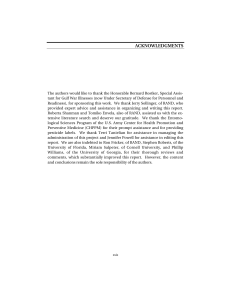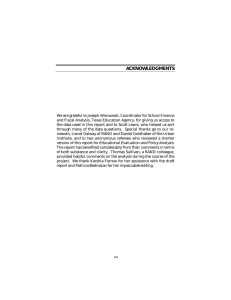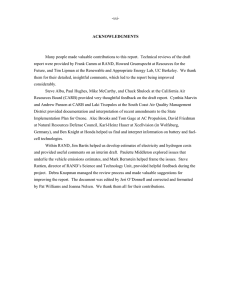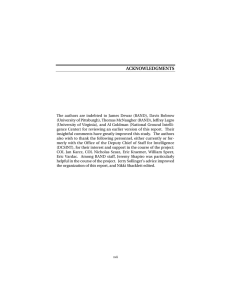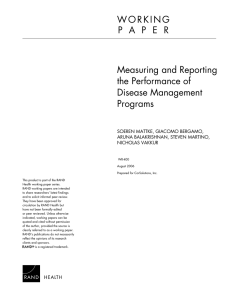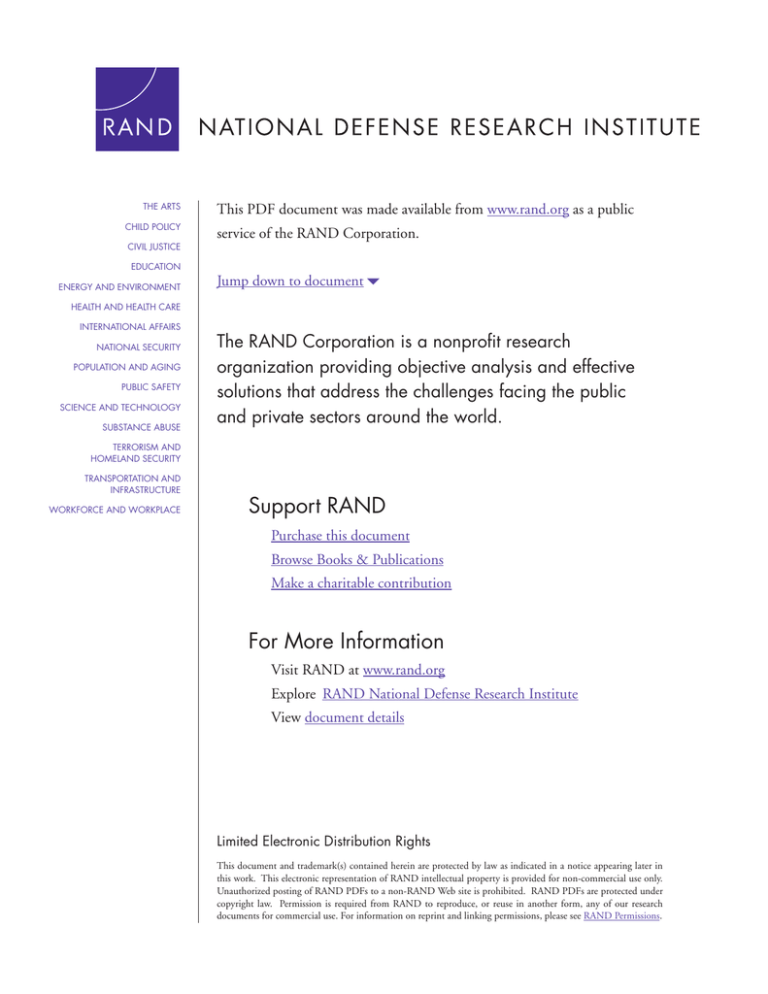
THE ARTS
CHILD POLICY
CIVIL JUSTICE
EDUCATION
ENERGY AND ENVIRONMENT
This PDF document was made available from www.rand.org as a public
service of the RAND Corporation.
Jump down to document6
HEALTH AND HEALTH CARE
INTERNATIONAL AFFAIRS
NATIONAL SECURITY
POPULATION AND AGING
PUBLIC SAFETY
SCIENCE AND TECHNOLOGY
SUBSTANCE ABUSE
The RAND Corporation is a nonprofit research
organization providing objective analysis and effective
solutions that address the challenges facing the public
and private sectors around the world.
TERRORISM AND
HOMELAND SECURITY
TRANSPORTATION AND
INFRASTRUCTURE
WORKFORCE AND WORKPLACE
Support RAND
Purchase this document
Browse Books & Publications
Make a charitable contribution
For More Information
Visit RAND at www.rand.org
Explore RAND National Defense Research Institute
View document details
Limited Electronic Distribution Rights
This document and trademark(s) contained herein are protected by law as indicated in a notice appearing later in
this work. This electronic representation of RAND intellectual property is provided for non-commercial use only.
Unauthorized posting of RAND PDFs to a non-RAND Web site is prohibited. RAND PDFs are protected under
copyright law. Permission is required from RAND to reproduce, or reuse in another form, any of our research
documents for commercial use. For information on reprint and linking permissions, please see RAND Permissions.
This product is part of the RAND Corporation occasional paper series. RAND
occasional papers may include an informed perspective on a timely policy issue, a
discussion of new research methodologies, essays, a paper presented at a conference, a
conference summary, or a summary of work in progress. All RAND occasional papers
undergo rigorous peer review to ensure that they meet high standards for research
quality and objectivity.
R A N D C O U N T E R I N S U R G E N C Y S T U DY • PA P E R 3
Understanding
Proto-Insurgencies
Daniel Byman
Prepared for the Office of the Secretary of Defense
Approved for public release; distribution unlimited
NATIONAL DEFENSE R ESEA R C H I N ST I T U T E
The research described in this report was prepared for the Office of the Secretary of
Defense (OSD). The research was conducted in the RAND National Defense Research
Institute, a federally funded research and development center sponsored by the OSD, the
Joint Staff, the Unified Combatant Commands, the Department of the Navy, the Marine
Corps, the defense agencies, and the defense Intelligence Community under Contract
W74V8H-06-C-0002.
Library of Congress Cataloging-in-Publication Data
Byman, Daniel, 1967Understanding proto-insurgencies / Daniel L. Byman.
p. cm. — (Rand counterinsurgency study ; paper 3)
Includes bibliographical references.
ISBN 978-0-8330-4136-4 (pbk. : alk. paper)
1. Counterinsurgency. 2. Insurgency. 3. Terrorism—Prevention. 4. United States—Foreign relations.
5. United States—Influence. I. Title.
U241.B95 2007
355.02'18—dc22
2007034546
The RAND Corporation is a nonprofit research organization providing objective analysis
and effective solutions that address the challenges facing the public and private sectors
around the world. RAND’s publications do not necessarily reflect the opinions of its
research clients and sponsors.
R® is a registered trademark.
© Copyright 2007 RAND Corporation
All rights reserved. No part of this book may be reproduced in any form by any electronic or
mechanical means (including photocopying, recording, or information storage and retrieval)
without permission in writing from RAND.
Published 2007 by the RAND Corporation
1776 Main Street, P.O. Box 2138, Santa Monica, CA 90407-2138
1200 South Hayes Street, Arlington, VA 22202-5050
4570 Fifth Avenue, Suite 600, Pittsburgh, PA 15213-2665
RAND URL: http://www.rand.org
To order RAND documents or to obtain additional information, contact
Distribution Services: Telephone: (310) 451-7002;
Fax: (310) 451-6915; Email: order@rand.org
Summary
Small bands of fighters and terrorist groups usually seek to become full-blown insurgencies as
part of their strategy for victory. But their task is difficult. The groups often start out with few
members, little funding, and limited recognition, while the governments they oppose enjoy
coercive and financial advantages and are seen as legitimate by most domestic and international audiences. Despite these difficulties, some groups do make the successful transition to
full-blown insurgency. That transition is the focus of this paper.
The Tasks Before the Proto-Insurgent
To gain the size and capabilities of an insurgency, a terrorist group or other would-be insurgent
movement must take several steps:
• First, proto-insurgents must create a politically relevant identity—a surprisingly difficult task. Success requires undermining rival identities put forward by the state or other
groups and convincing people that the group comprises Muslims, Kurds, or whatever
particular identity it champions. This identity is the basis for a group’s subsequent organization and expansion.
• Second, the identity must be linked to a cause that is popular beyond the terrorist group
or band of insurrectionists. Many causes championed by proto-insurgents have little
inherent popularity, and governments can often co-opt the more popular elements of a
cause. Nationalism is perhaps the most potent cause to harness.
• Third, the proto-insurgents must gain dominance over their rivals. The primary foe at
this early stage is not the government, but the welter of rival organizations that compete
for recruits and money. Many of these organizations seek to exploit the same cause as does
the proto-insurgent, but they use a different identity or platform to do so. Not surprisingly,
proto-insurgent energies are often consumed by fights within their own community.
• Finally, proto-insurgents need a respite from police, intelligence, and military services.
Many groups thus find that a sanctuary or “no go” zone is often essential for their
survival.
Violence is instrumental in all the tasks proto-insurgencies seek to accomplish. Violence
can aid recruitment, attracting media attention and separating the group from more peaceful,
vii
viii
Understanding Proto-Insurgencies
and thus more accommodating, rivals. Even when it fails to inspire, violence can intimidate
citizens into supporting the would-be insurgents, or at least not supporting the government.
Violence also forms a bond within the group and makes the moderate option less tenable. In
part, this occurs through intimidation: Moderates are often the first target for radical groups.
Also, the climate of violence over time makes promises of moderation wear thin. Perhaps most
important, violence reduces confidence in government administrative and police structures by
demonstrating that the government cannot fulfill its most essential task, that of protecting the
citizenry.
Violence, however, can also backfire on the proto-insurgents. Simply put, few people support violence. Thus proto-insurgents face the dilemma of deciding whether and how much to
target civilian populations. They seek to provoke a reaction from a government or from rival
groups but not to alienate their constituencies.
The success or failure of a proto-insurgent movement depends only in part (and at times
only in small part) on its own campaign. The reaction of the state is often the most important
factor in a movement’s overall success. In particular, states can disrupt organizations through
various forms of policing and repression and can co-opt potential leaders and make them allies
of the state. States can also divide the identity that proto-insurgents wish to put forward.
Some regimes are unable to implement effective repressive measures, while others can
capitalize on circumstances that increase the effectiveness of control. The resources of the
would-be insurgent group, the level of outside backing, its access to arms, its social structure,
and the type of regime are among the many factors that affect the effectiveness of control. Governments with a high degree of popular support and skilled police and intelligence services are
more likely to implement control policies more effectively.
The Role of Outside Support
State support offers numerous advantages to groups seeking to become insurgencies. Outside states can offer a safe haven that groups often lack. They can also offer money, training,
and help with political mobilization. State support also helps groups overcome logistical difficulties and hinders intelligence-gathering against them. Finally, state support legitimizes a
proto-insurgent group and makes government delegitimization efforts almost impossible. Such
backing can help a group resist government counterterrorism and counterinsurgency (COIN)
campaigns.
Despite all these benefits, state support is a mixed blessing. Even the most supportive and
ideologically sympathetic regimes have their own distinct national interests and domestic politics, making them unlikely to completely embrace the proto-insurgents’ agenda. Proto-insurgents may also lose freedom of action, as states fear risking an all-out confrontation and thus
put a brake on their proxies. At times, a purported backer will deliberately try to weaken the
overall movement, even as it supports particular groups. Finally, outside support can hinder a
group’s effort to harness nationalism.
Summary
ix
Defeating Proto-Insurgencies
Governments opposing proto-insurgencies must recognize the proto-insurgents’ many weaknesses and avoid an overreaction that may inadvertently strengthen the group. Perhaps the best
and most efficient way to prevent proto-insurgents from gaining ground is through “in-group”
policing. Individual communities know their own members, particularly in tight-knit societies in the developing world. These communities thus make intelligence-gathering easier and
enable the use of arrests or other forms of pressure with far greater discrimination. In-group
policing, of course, requires a government to work with more-moderate members of a community and often to make political concessions to them.
States can also promote rival identities. Ideally, states can build up the national identity
to increase bonds among citizens. They can use powerful tools such as education, control of
language, and influence over the media to build a rival identity to the one the proto-insurgents
support. Alternatively, they can also divide the identity of the proto-insurgent movement.
The most obvious action for the United States to take in its COIN campaign is to anticipate the possibility of an insurgency developing before it materializes. Many of the recommended steps are relatively low cost and easy to implement, especially when compared with
fighting a full-blown insurgency. Indicators of potential insurgencies are discussed in Appendix C.
It is often important for the United States to stay in the background when dealing with
potential insurgencies. Since the best cause for insurgents to harness is nationalism, direct and
open U.S. support of a government can undercut that government’s legitimacy. The United
States can, however, provide training and advisory programs that are largely behind the scenes,
particularly if they are conducted outside the country. These programs should focus on improving indigenous capabilities rather than on substituting U.S. roles for them.
Building a strong police force is also important—usually much more important than
aiding the military. Police typically are far better suited to defeating small groups, because
they know the communities well and are trained to use force discriminately. Success in defeating insurgent movements requires not only that the police be strong and numerous, but
that the laws they enforce be suited for counterinsurgency. Thus, legal reform is a vital early
step in counterinsurgency. Creating programs that combine the talents of military officers,
police officials, and intelligence professionals would be an important step forward in fighting
proto-insurgents.
Intelligence should also be redirected to focus on the conditions that foster insurgency
as well as on the presence of insurgencies. Once an insurgency is manifest, it is far harder to
defeat. Identifying would-be insurgents and assessing their chances of success thus is a highly
effective way to help direct resources.
Finally, the United States can help inhibit outside support for proto-insurgencies. U.S.
power is often better directed at coercing hostile states than it is at directly fighting insurgents
within friendly countries.

